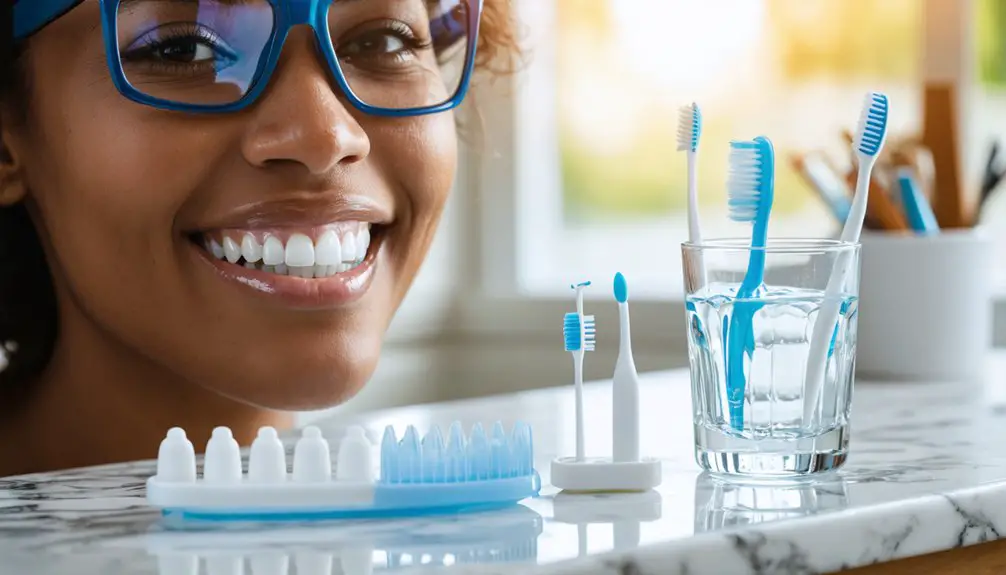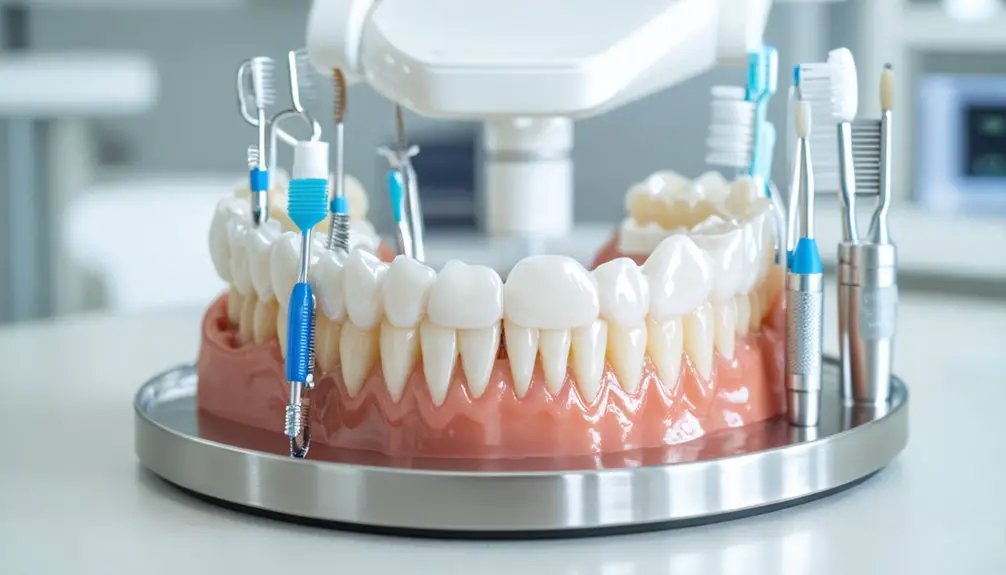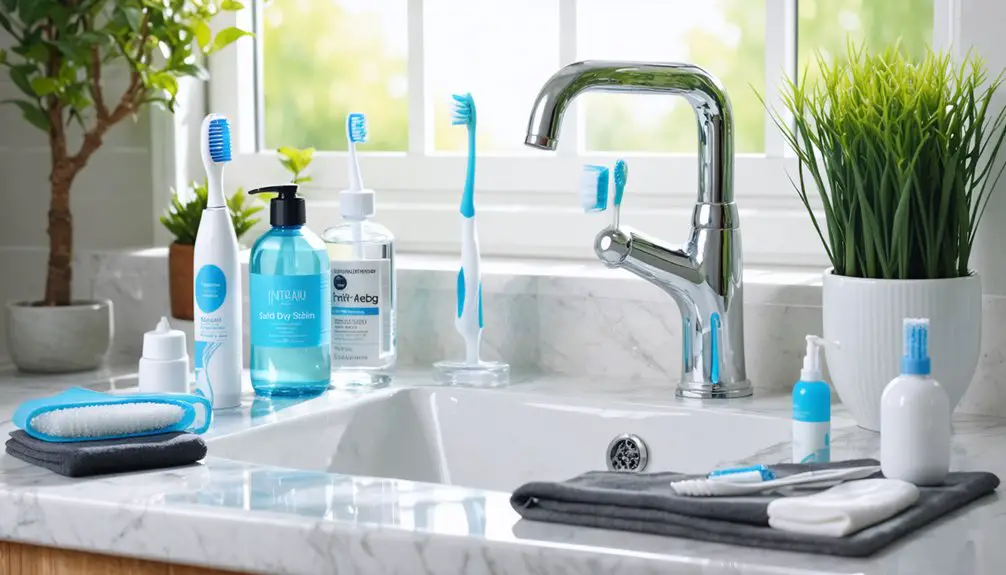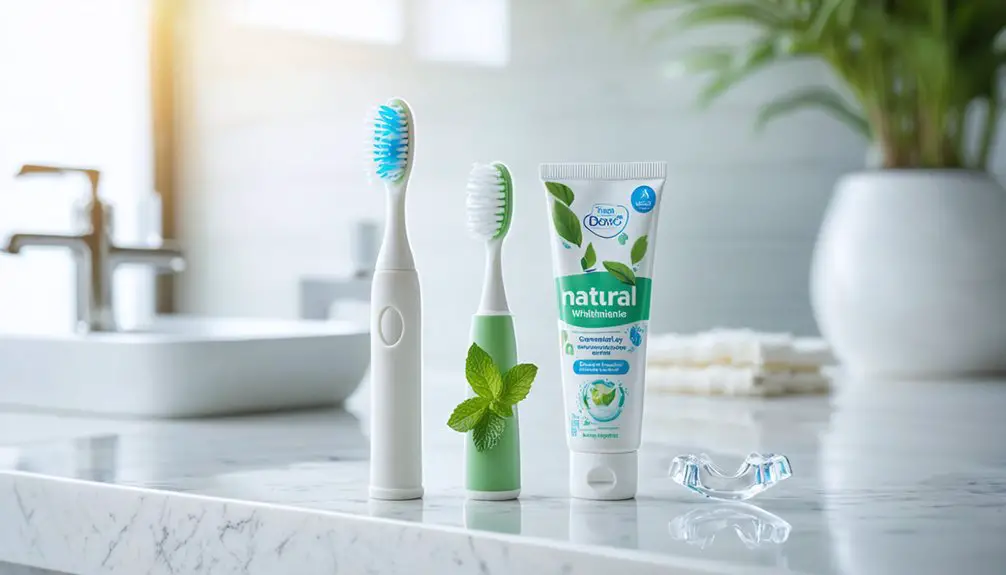You’ll minimize teeth whitening risks by choosing professional supervision over DIY methods and starting with lower peroxide concentrations under 10%. Follow treatment time guidelines strictly, never exceeding recommended durations. Protect your enamel before and after treatment with fluoride products while avoiding abrasive substances. Monitor any sensitivity issues and use desensitizing toothpaste as needed. These evidence-based strategies will help guarantee safe, effective results for your smile.
Key Takeaways
- Seek professional dental supervision for customized treatment plans and monitoring rather than using DIY whitening methods.
- Start with low peroxide concentrations (10% or less) to protect tooth enamel and minimize sensitivity risks.
- Follow manufacturer guidelines strictly for treatment duration and never exceed recommended wear times.
- Use fluoride-based products and avoid abrasive substances to protect and strengthen enamel before and after treatment.
- Address sensitivity immediately with desensitizing toothpaste and avoid hot/cold foods for 48 hours post-treatment.
Choose Professional Guidance Over DIY Methods
While over-the-counter teeth whitening products may seem convenient and cost-effective, professional dental supervision provides considerably safer and more reliable results.
When you choose professional expertise, you’ll receive customized treatment plans that target your specific type of discoloration while minimizing risks of sensitivity and gum irritation.
Your dentist will screen for potential contraindications, determine ideal bleaching concentrations, and monitor your progress throughout treatment. This personalized approach helps prevent enamel damage and guarantees compliance with safety standards. Lower concentration treatments using 10% carbamide peroxide show significantly reduced side effects while maintaining effectiveness.
The long-term cost benefits become apparent through better outcomes, fewer complications, and longer-lasting results. Professional treatments typically achieve up to 10 shades of improvement in a single session, compared to the gradual and unpredictable results of DIY methods. With the global whitening market reaching $6.14 billion, professional services have become increasingly accessible and advanced.
You’ll also receive valuable maintenance advice to extend your whitening results.
Start With Lower Peroxide Concentrations
Safety considerations in teeth whitening begin with selecting the right peroxide concentration for your treatment. Starting with lower concentrations offers significant peroxide safety benefits while still achieving noticeable results.
Store-bought whitening products typically contain 3-10% hydrogen peroxide, making them a safer starting point. Begin with 10% carbamide peroxide or less to protect your enamel’s protein structure and minimize potential damage. Higher concentrations can reduce enamel proteins by up to 50% and may cause dental pulp cell death. Research shows that dental cell mortality increases significantly with exposure to higher concentrations of carbamide peroxide.
The lower concentration benefits include reduced tooth sensitivity, less soft tissue irritation, and better preservation of tooth structure integrity.
While lower concentrations require longer treatment times, they’ll help you avoid the increased risks associated with higher peroxide levels. Monitor for sensitivity during initial applications and adjust accordingly.
If needed, gradually increase concentration only under professional guidance to guarantee ideal results while maintaining dental health.
Follow Treatment Time Guidelines Strictly
Beyond selecting the right peroxide concentration, precise timing of your whitening treatment stands as a key factor in achieving safe results.
You’ll need to strictly follow manufacturer guidelines for treatment duration, typically ranging from 30 minutes to one hour for first-time users. Don’t exceed recommended wear times, as this can compromise enamel safety and trigger sensitivity. Natural teeth have yellowish undertones, so avoid overwhitening in pursuit of unnaturally bright results.
Monitor your response to treatment carefully. If you experience discomfort, reduce exposure time immediately. Those experiencing tooth sensitivity should use less frequent treatments to minimize side effects.
For maintenance sessions, limit applications to about one hour daily for 7-10 days, followed by occasional touch-ups. Remember that professional treatments under dental supervision restrict exposure to 15-20 minutes per session for ideal safety.
Always remove excess gel promptly after treatment to prevent gum irritation, and maintain proper intervals between sessions to protect your enamel’s integrity.
Protect Your Enamel Before and After Treatment
Before starting any teeth whitening regimen, protecting your tooth enamel requires a thorough approach that extends well beyond the treatment itself.
Choose fluoride-based whitening products specifically designed for sensitive teeth, and avoid abrasive substances like activated charcoal or acidic solutions.
For safe teeth whitening, opt for gentle fluoride formulas made for sensitivity and steer clear of harsh abrasives and acids.
Implement enamel remineralization techniques by using fluoridated mouthwash and waiting 30 minutes after acidic foods before brushing.
Make protective dietary choices by limiting acidic beverages and using straws when consuming them. Since enamel cannot regenerate, taking preventive measures is crucial for long-term oral health.
Pair acidic foods with alkaline options to neutralize their effects.
You’ll also want to maintain proper oral hygiene with soft-bristled brushes and regular flossing.
Using high-strength peroxide in whitening products can weaken tooth enamel, so always follow product instructions carefully.
Consider professional supervision for your whitening treatment, and ask your dentist about preventive fluoride treatments to strengthen your enamel beforehand.
Monitor and Address Sensitivity Issues
When undergoing teeth whitening treatment, monitoring sensitivity is essential since up to 78% of patients experience some level of discomfort.
Through proper sensitivity monitoring, you’ll be able to adjust your treatment plan before discomfort becomes severe enough to halt the process.
Using desensitizing toothpaste can help block nerve pathways and reduce discomfort during whitening treatments.
If you notice increased sensitivity, inform your dental provider immediately. They can modify your treatment by reducing peroxide concentration or shortening application times while still maintaining effectiveness.
During the first 24-48 hours after treatment, avoid hot and cold foods and beverages to prevent nerve irritation.
For patients with pre-existing conditions like gum recession or thin enamel, special treatment adjustments may be necessary.
The hydrogen peroxide in whitening products breaks down stains by penetrating the tooth enamel.
Frequently Asked Questions
How Long Should I Wait Between Teeth Whitening Treatments?
You’ll need 6-12 months between professional treatments and 2-4 weeks between at-home whitening sessions. Don’t rush your whitening frequency – your teeth aren’t competing in a beauty pageant.
Can I Drink Coffee Through a Straw During Whitening Treatment?
You shouldn’t drink coffee at all during the first 48-72 hours post-whitening. After that period, using a straw offers some benefits, but consider coffee alternatives like water or milk initially.
Will Teeth Whitening Work on Dental Crowns or Veneers?
No, you can’t whiten crowns or veneers since they’re non-porous materials. While whitening won’t affect your restorations’ longevity, you’ll need professional maintenance or replacement to match newly whitened natural teeth.
Are Natural Whitening Methods Like Charcoal and Baking Soda Safe Alternatives?
While charcoal’s effectiveness is limited and risky for your enamel, baking soda offers a safer natural whitening alternative when used sparingly. Mix it with fluoride toothpaste and brush gently to protect your teeth.
Does Fluoride Treatment Before Whitening Help Prevent Sensitivity Issues?
You’ll experience significant sensitivity reduction when you get professional fluoride application before whitening. It strengthens your enamel, seals exposed dentin tubules, and creates a protective barrier against whitening agents.
References
- https://www.nature.com/articles/s41415-019-0188-8
- https://bestsmilesdentist.com/can-teeth-whitening-damage-your-enamel/
- https://ec.europa.eu/health/scientific_committees/opinions_layman/en/tooth-whiteners/l-3/5-tooth-whitening-products.htm
- https://www.loudfamilydentistry.com/blog/teeth-whitening-related-statistics-on-effectiveness-and-sensitivity-incidence
- https://www.aapd.org/globalassets/media/publications/archives/lee-27-5.pdf
- https://www.thedentalspajersey.com/blog/teeth-whitening-statistics-2024
- https://www.newlifedentistry.com/blog/top-5-reasons-to-choose-professional-teeth-whitening
- https://pmc.ncbi.nlm.nih.gov/articles/PMC4058574/
- https://www.frontiersin.org/journals/dental-medicine/articles/10.3389/fdmed.2021.687507/full
- https://www.utoronto.ca/news/u-t-researcher-examines-damaging-effects-teeth-whitening-products-dental-cells



